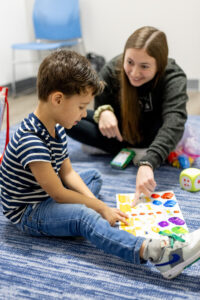
When a speech therapy session ends, that doesn’t mean the practice stops. As a matter of fact, some of the biggest leaps in a child’s speech development journey happen outside of sessions—in everyday situations like bed or bath time. So why not take advantage of this? Why not make the learning process fun and exciting for both you and your child? In this blog, we’re going to cover seven speech therapy activities you can do to ensure your child is constantly working on their communication skills.
Activity 1: Mirror Imitation Game
What to Do: We’ll start with one of our favorite speech activities. Grab a mirror—or just stand in front of the one in the bathroom—and make all kinds of silly faces, having your child mimic them afterwards. It’s a fun little game that’s guaranteed to cause plenty of laughter. Want to take it a step further? Add sounds and words into the mix!
Why It Helps: Mimicry is a huge part of how children learn to communicate and express themselves. They can connect words and facial expressions with emotions, and catch on to goofy behavior as well. When you add their reflection into the mix, it helps that process even more. They become aware of how they’re forming sounds, and it helps them boost their articulation and self-correction skills.
Activity 2: Story Time With a Twist
What to Do: Every child loves a good story. Not only do they like hearing their parents speak to them, but they begin to identify with their favorite characters from their books. During story time, try to pause every now and then to ask your child what they think will happen next. You can also point to characters on the page and ask them to identify them.
Why It Helps: This tactic strengthens your child’s comprehension and boosts their vocabulary in a meaningful way. It also encourages increasingly expressive language. You may begin to notice your child gets more excited about reading when you include them in the story, meaning they’ll be more invested in learning the words and expressions within the pages.
Activity 3: “I Spy” With a Speech Focus
What to Do: Who doesn’t love a good game of “I Spy”? What if we told you there’s a way to use it to teach your little one? While the classic game everyone loves includes questions like, “I spy a dog,” our version is a little different. Select objects that begin with a target sound—like something that starts with “s”—or belong to a category, such as animals or colors.
Why It Helps: This beloved game helps children get plenty of practice making specific sounds and associating them with the correct objects. Word retrieval and categorization skills also get a big boost when you’re playing!
Activity 4: Blow Bubbles or Use a Straw
What to Do: Spend some time out on the front porch with bubble solution and a wand, blowing bubbles to your child’s delight. And while you’re at it, make the whole experience even more enjoyable while sipping a smoothie through a straw.
Why It Helps: We know, we know. This isn’t like most speech activities, because they don’t involve talking at all (though plenty of joyful laughter will likely take place), but your child will be working out muscles that are vital to clear speech production.
Activity 5: Sing Songs With Repetition and Rhyme
What to Do: Of course one of our favorite speech therapy activities involves singing! Nursery rhymes and simple songs are a great way to have fun with your child. If they get distracted, encourage them to join in on repetitive parts.
Why It Helps: Music is a great tool for teaching children phonetic awareness and rhythm. In addition, their memory is getting better when they retain the actual lyrics to these songs. All of these are vital building blocks for language development.
Activity 6: Picture Cards or Flash Cards
What to Do: Make some flash cards with fun, colorful pictures and their corresponding words or sounds. With your child, practice making these sounds, naming the objects on the cards, or even using several cards to make up a short story!
Why It Helps: This is a great vehicle for reinforcing proper pronunciation, introducing new vocabulary, and making speech practice overall more visual and engaging.
Activity 7: Daily Routine Narration
What to Do: As you go about your day with your child, simply narrate what you’re doing and what’s going on around you (“I’m putting the laundry in the dryer” or “We’re setting the table for dinner.”) Every now and then, ask your child basic questions that will spark a conversation.
Why It Helps: As far as speech therapy activities go, this one isn’t particularly fun, but boy is it helpful! Explaining daily routines means even the most mundane tasks and chores can be turned into learning activities. By telling your child what’s going on in the moment, you’re helping them build their vocabulary and sentences within a real-world context.
So Many Opportunities for Speech Therapy Activities!
Practicing speech with your child can happen in way more situations than a therapy session. When you get into the habit of turning fun moments into speech therapy activities—while keeping them exciting—your child will be learning without even realizing it! We truly hope these tips will help you out, but you know we’re always here for you and your child when a little extra help is needed. Contact us for additional information or to schedule an appointment!









